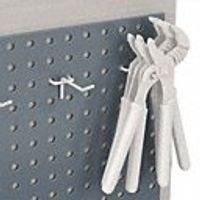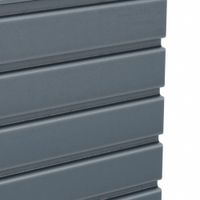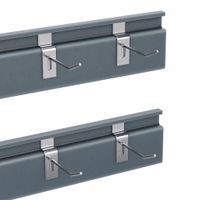Call +(254) 703 030 000 / 751 483 999 / 721 704 777
- Home
- Material Handling
- Storage Workspace
- Storage Panels Panel Racks
.....Read More
Frequently Asked Questions
What are the differences between pegboard, slatwall, louvered, and wire grid panels?
Pegboard panels are perforated boards with evenly spaced holes, typically made from wood, metal, or composite materials. They are used for hanging tools and accessories using hooks and pegs. Pegboards are versatile and easy to customize but may require reinforcement for heavy items.
Slatwall panels consist of horizontal grooves or slats, usually made from medium-density fiberboard (MDF) or PVC. Accessories like hooks, shelves, and baskets can be inserted into the slats. Slatwalls offer a sleek appearance and are ideal for retail displays, providing flexibility in arranging items.
Louvered panels are metal panels with rows of louvers or slots designed to hold bins and containers. They are commonly used in industrial and warehouse settings for organizing small parts and tools. Louvered panels are durable and can support heavy loads, making them suitable for heavy-duty storage needs.
Wire grid panels are made from metal wire formed into a grid pattern. They are lightweight and easy to install, often used in retail and home settings for displaying merchandise or organizing items. Wire grids allow for good visibility and airflow, but may not support as much weight as other panel types.
In summary, pegboards are ideal for tool organization, slatwalls for retail displays, louvered panels for industrial storage, and wire grids for lightweight, versatile displays.
How do I choose the right storage panel system for my needs?
To choose the right storage panel system, first assess your specific needs by considering the following factors:
1. **Purpose and Usage**: Determine what you need to store. Is it tools, office supplies, or household items? This will guide the type of storage system you require.
2. **Space Availability**: Measure the area where the storage system will be installed. Consider vertical space for wall-mounted panels if floor space is limited.
3. **Weight Capacity**: Check the weight capacity of the storage panels. Ensure they can support the weight of the items you plan to store.
4. **Material and Durability**: Choose materials that suit your environment. Metal panels are durable for heavy-duty use, while plastic or wood may suffice for lighter items.
5. **Flexibility and Modularity**: Opt for systems that allow for reconfiguration or expansion. Modular systems can adapt to changing storage needs.
6. **Aesthetic and Design**: Consider the design and color of the panels to ensure they match the decor of the space.
7. **Ease of Installation**: Evaluate how easy it is to install the system. Some may require professional installation, while others are DIY-friendly.
8. **Budget**: Set a budget and compare different systems within that range. Consider long-term value over initial cost.
9. **Brand and Reviews**: Research brands and read customer reviews to gauge reliability and satisfaction.
10. **Accessories and Compatibility**: Check for available accessories like hooks, bins, or shelves that enhance functionality. Ensure compatibility with existing systems if applicable.
By considering these factors, you can select a storage panel system that effectively meets your needs and optimizes your space.
What types of accessories are compatible with storage panels and racks?
Storage panels and racks are versatile systems used for organizing and storing various items. The types of accessories compatible with these systems include:
1. **Bins and Containers**: These are used for storing small parts and components. They come in various sizes and can be easily attached to panels and racks.
2. **Shelves**: Adjustable shelves can be added to racks to accommodate items of different sizes. They can be made of metal, wood, or plastic.
3. **Hooks and Pegs**: These are used for hanging tools, equipment, or other items. They come in different shapes and sizes to hold various objects securely.
4. **Brackets**: Used to support shelves or other components, brackets are essential for creating a stable storage system.
5. **Drawers**: These can be integrated into racks for storing items that need to be kept out of sight or protected from dust.
6. **Dividers**: Used within bins or on shelves, dividers help in organizing items by creating separate compartments.
7. **Label Holders**: These are used for labeling bins, shelves, or sections of the rack to ensure easy identification of stored items.
8. **Panels**: Perforated or slat panels can be added to racks for additional storage options, allowing for the attachment of hooks, bins, and other accessories.
9. **Cable Management Accessories**: These include clips and ties to organize and secure cables, preventing tangling and damage.
10. **Lighting**: LED strips or other lighting solutions can be added to improve visibility in storage areas.
11. **Security Accessories**: Locks and doors can be added to racks to secure valuable or sensitive items.
12. **Wheels and Casters**: These can be attached to racks for mobility, allowing for easy repositioning of storage units.
These accessories enhance the functionality and efficiency of storage panels and racks, making them adaptable to various organizational needs.
How do I install storage panels and racks on different wall types?
1. **Identify Wall Type**: Determine if the wall is drywall, concrete, brick, or wood. This affects the tools and fasteners you'll need.
2. **Gather Tools and Materials**: Common tools include a drill, level, tape measure, stud finder, and appropriate fasteners (screws, anchors, etc.).
3. **Locate Studs or Support**:
- **Drywall**: Use a stud finder to locate studs. Mark their positions.
- **Concrete/Brick**: Use a masonry bit and anchors.
- **Wood**: Directly screw into the wood.
4. **Mark Layout**: Use a level and tape measure to mark where the panels and racks will be installed. Ensure they are evenly spaced and level.
5. **Drill Pilot Holes**:
- **Drywall**: Drill into studs or use drywall anchors if no stud is available.
- **Concrete/Brick**: Use a masonry drill bit to create holes for anchors.
- **Wood**: Drill pilot holes to prevent splitting.
6. **Install Anchors** (if needed):
- **Drywall**: Insert drywall anchors into the holes.
- **Concrete/Brick**: Insert masonry anchors.
7. **Mount Panels/Racks**:
- Align the panels or racks with the marked layout.
- Secure them using screws or bolts, ensuring they are tightly fastened.
8. **Check Stability**: Ensure the panels and racks are securely mounted and can support the intended weight.
9. **Adjust and Organize**: Adjust any movable parts and organize items on the racks.
10. **Safety Check**: Double-check all fastenings and ensure everything is secure to prevent accidents.
Can storage panels and racks support heavy tools and equipment?
Yes, storage panels and racks can support heavy tools and equipment, but their capacity depends on several factors, including the design, material, and installation method.
1. **Design and Material**: Storage panels and racks are available in various designs and materials, such as steel, aluminum, and heavy-duty plastic. Steel racks are typically the most robust and can support significant weight, making them suitable for heavy tools and equipment. The design, including the thickness of the material and the structural reinforcements, also plays a crucial role in determining the load capacity.
2. **Load Capacity**: Each storage panel or rack comes with a specified load capacity, which indicates the maximum weight it can safely support. It is essential to adhere to these specifications to prevent structural failure. For heavy tools and equipment, selecting racks with a high load capacity is crucial.
3. **Installation**: Proper installation is vital for ensuring that storage panels and racks can support heavy loads. Wall-mounted racks must be securely anchored to studs or other structural supports to handle the weight. Freestanding racks should be placed on a level surface and may require additional bracing or anchoring for stability.
4. **Distribution of Weight**: Even with high-capacity racks, distributing the weight evenly across the storage surface is important to prevent overloading specific areas, which could lead to bending or collapse.
5. **Regular Maintenance**: Regular inspection and maintenance of storage panels and racks are necessary to ensure they remain in good condition and continue to support heavy loads safely. This includes checking for signs of wear, corrosion, or damage.
In summary, with the right design, material, installation, and maintenance, storage panels and racks can effectively support heavy tools and equipment.
What are the best storage panel systems for small spaces?
1. **Pegboards**: Versatile and customizable, pegboards can be mounted on walls to hold tools, kitchen utensils, or office supplies. They allow for easy rearrangement and can be painted to match decor.
2. **Slatwall Panels**: Commonly used in retail, slatwall panels are great for small spaces as they can hold a variety of hooks, baskets, and shelves. They are ideal for garages, workshops, or craft rooms.
3. **Gridwall Panels**: Similar to slatwalls, gridwall panels are metal grids that can be mounted on walls. They are sturdy and can support shelves, hooks, and baskets, making them suitable for organizing various items.
4. **Over-the-Door Organizers**: These systems utilize the back of doors for storage, perfect for small spaces. They can hold shoes, cleaning supplies, or pantry items, freeing up floor and shelf space.
5. **Floating Shelves**: These shelves provide storage without taking up floor space. They can be installed in any room to hold books, decor, or kitchenware, and come in various styles to suit different aesthetics.
6. **Magnetic Strips**: Ideal for kitchens and workshops, magnetic strips can hold knives, tools, or other metal objects. They save drawer space and keep items easily accessible.
7. **Wall-Mounted Cabinets**: For more concealed storage, wall-mounted cabinets can be installed in kitchens, bathrooms, or offices. They keep items out of sight while maximizing vertical space.
8. **Foldable Wall Desks**: These desks can be folded up when not in use, providing a workspace without occupying permanent space. They often include shelves or compartments for additional storage.
9. **Corner Shelves**: Utilizing corner spaces, these shelves can hold plants, books, or decorative items, making use of often-overlooked areas.
10. **Tension Rods**: Useful in closets or under sinks, tension rods can hold cleaning supplies, hang clothes, or create divisions in storage areas.
How do I maintain and clean storage panels and racks?
To maintain and clean storage panels and racks effectively, follow these steps:
1. **Regular Inspection**: Conduct routine checks for any signs of damage, rust, or wear. Address issues immediately to prevent further deterioration.
2. **Dusting**: Use a microfiber cloth or a soft brush to remove dust and debris from surfaces. For hard-to-reach areas, a vacuum with a brush attachment can be effective.
3. **Cleaning Solutions**: Prepare a mild cleaning solution using water and a gentle detergent. Avoid harsh chemicals that can damage the finish or corrode metal parts.
4. **Wiping Down**: Dampen a cloth with the cleaning solution and wipe down all surfaces, including shelves, beams, and supports. Ensure the cloth is not too wet to prevent moisture damage.
5. **Drying**: After cleaning, use a dry cloth to remove any remaining moisture. This step is crucial to prevent rust and corrosion, especially on metal racks.
6. **Rust Prevention**: Apply a rust inhibitor or protective coating on metal surfaces to prevent rust. Regularly check and reapply as needed.
7. **Lubrication**: For movable parts, such as sliding shelves or adjustable racks, apply a suitable lubricant to ensure smooth operation and prevent wear.
8. **Load Management**: Ensure that the weight on the racks is evenly distributed and does not exceed the recommended capacity. Overloading can lead to structural damage.
9. **Organizational Practices**: Keep the storage area organized to facilitate easy cleaning and maintenance. Label shelves and maintain a clear layout to avoid clutter.
10. **Safety Checks**: Regularly check for loose bolts or connections and tighten them as necessary. Ensure that all safety features, such as locking mechanisms, are functioning properly.
By following these steps, you can maintain the integrity and longevity of your storage panels and racks, ensuring a safe and efficient storage environment.




